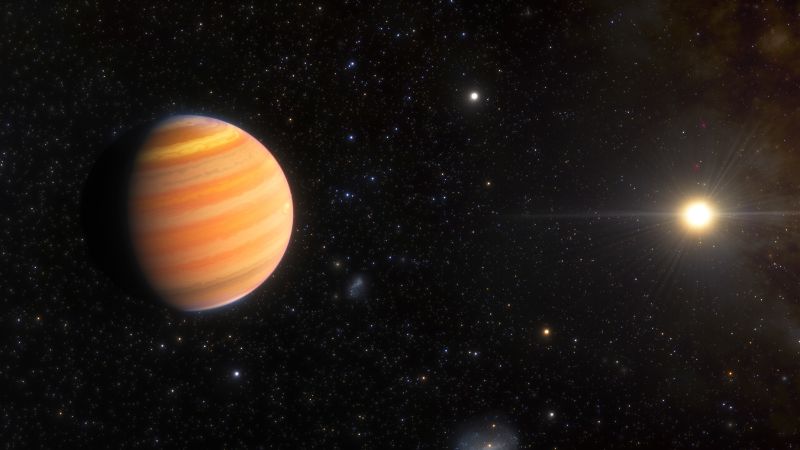Sign up for CNN’s Wonder Theory science newsletter. Explore the universe with news of fascinating discoveries, scientific breakthroughs and more.
CNN
—
Astronomers have discovered an exoplanet with a highly elongated orbit that experiences unusual temperature fluctuations – and may be transiting to another type of world.
The exoplanet, called TIC 241249530 b, orbits a star about 1,100 light-years from Earth. The star is one of a binary pair, so the planet orbits the primary star while the primary star orbits a secondary star.
Interactions between the two stars, which have an irregular orbit, may be responsible for putting this planet on track to become a “hot Jupiter,” researchers reported in a study published Wednesday in the journal Nature.
Astronomers have found more than 5,600 confirmed exoplanets, and 300 to 500 of them are “hot Jupiters.” These planets are massive Jupiter-like gaseous bodies that orbit their host stars in tight orbits that heat them to scorching temperatures.
While Jupiter takes 4,000 Earth days to make one revolution around the sun, hot Jupiters make one revolution every few days.
Scientists believe that large planets begin orbiting their stars from a distance, but migrate closer over time. But they have long questioned how massive worlds end up in such tight orbits that are much closer to their stars than Mercury is to our sun.
Observations of TIC 241249530 b, first captured by NASA’s planet-hunting satellite TESS in January 2020, offer rare, candid insights into what might be a planet about to become a hot Jupiter.
“Astronomers have been looking for exoplanets that are likely progenitors of hot Jupiters, or that are intermediates in the migration process, for more than two decades, so I was very surprised — and excited — to find one,” said lead study author Arvind Gupta, a postdoc a NOIRLab researcher who discovered the planet as a doctoral student at Penn State, in a statement.
On January 12, 2020, the Transiting Exoplanet Survey Satellite collected data that suggests something is passing in front of the host star TIC 241249530. TESS monitors the brightness of nearby stars to look for dips in starlight that might indicate the presence of exoplanets .
Gupta and his colleagues tracked the data and found that a Jupiter-sized planet was passing in front of the star. They then took measurements using instruments on the WIYN 3.5-meter telescope at Kit Peak National Observatory in Arizona to determine the star’s radial velocity, or how much the star wobbles back and forth as the planet’s gravity pulls on the star.
The radial velocity data also confirmed the presence of the same planet and helped the researchers clarify that it is about five times more massive than Jupiter and has what astronomers call a highly eccentric orbit.
Astronomers use “eccentric” to denote the shape of a planet’s orbit on a scale of zero to 1. Zero equals a perfectly circular orbit. In our solar system, Earth has an eccentricity of 0.02, while Pluto’s highly oval orbit around the sun is considered to be 0.25.
The newly discovered exoplanet has an eccentricity of 0.94, which is more elongated than any other transiting exoplanet that astronomers have ever discovered, according to the researchers. The strange world takes about six months to complete one orbit around its host star, coming extremely close to the star before blowing wide and then returning to a narrow, oval, cucumber-shaped orbit.
“We caught this massive planet making a sharp turn during its close pass to its star,” study co-author Suvrat Mahadevan, the Verne M. Willaman Professor of Astronomy at Penn State, said in a statement. “Such highly eccentric transiting planets are incredibly rare – and it’s really amazing that we were able to find the most eccentric one.”
The planet is only 3 million miles from its star, more than 10 times closer to the star than Mercury gets to the sun. For reference, Mercury is an average distance of 36 million miles (58 million kilometers) from the sun, according to NASA.
The extreme orbit causes “huge temperature swings” over the course of the year on the planet, said study co-author Jason Wright, professor of astronomy and astrophysics at Penn State.
“The temperature at the cloud tops gets hot enough to melt the titan during the few days it screams past the close-up of the star,” Wright said by email. “During most of its orbit, it is further away, and at its farthest point the cloud’s daytime temperature is like a warm summer day on Earth.”
The research team also found that the planet is orbiting backwards, or moving in the opposite direction compared to the rotation of its star – a rare phenomenon not seen in most exoplanets and not occurring in our solar system.
All the oddities observed around TIC 241249530 b are helping astronomers understand how the planet formed.
“Although we can’t exactly press rewind and watch the planetary migration process in real time, this exoplanet serves as a sort of snapshot of the migration process,” Gupta said. “Planets like this are hard to find, and we hope this can help us unravel the hot story of Jupiter’s formation.”
The team ran simulations to determine how the planet might have gotten into such an unusual orbit, as well as how it might evolve over time. The simulations include modeling the gravitational interactions between TIC 241249530 b and its host star as well as the secondary star.
The research team calculated that the planet likely formed far from its host star and began in a wide, circular orbit similar to Jupiter. But the host star has an irregular orbit with the second star, which exerts gravitational forces on the planet and stretches its orbit, the researchers said.
“Over many orbits, the gravitational influence of this outer star changed the orbit of TIC 241249530 b, making it increasingly elongated,” Wright said.
With each pass of its host star, the planet’s orbit loses energy, so astronomers estimate that in hundreds of millions of years the orbit will contract and stabilize to last just a few days instead of the 167 days it takes now.
Then the planet would become a true hot Jupiter, said study co-author Sarah Milholland, an assistant professor of physics at MIT’s Institute for Astrophysics and Space Studies.
“It’s a pretty extreme process because the changes in the planet’s orbit are massive,” Milholland said. “It’s a big dance of orbits that’s been going on for billions of years, and the planet just keeps moving forward.”
Before TIC 241249530 b, the only other known early hot Jupiter was an exoplanet called HD 80606 b, discovered in 2001. HD 80606 b was thought to be the planet with the most eccentric orbit until the recent discovery.
HD 80606 b has an eccentricity of 0.93 and a shorter orbit of 111 days and orbits in the same direction as its star. But otherwise, the planets are practically twins, Wright said. Finding two planets in such a short stage of planetary orbital evolution is like “happening upon a butterfly at the moment its chrysalis opens,” he said.
The discovery of a second hot Jupiter progenitor helps astronomers confirm the idea that high-mass gas giants transform into hot Jupiters as they migrate from eccentric to circular orbits, researchers said.
The team hopes to observe TIC 241249530 b with the James Webb Space Telescope to reveal the dynamics of its atmosphere and see how it responds to such rapid heating. And the search continues for more planets like those that transform into hot Jupiters.
“This system highlights how incredibly diverse exoplanets can be,” Milholland said. “They’re mysterious other worlds that can have wild orbits that tell a story about how they got there and where they’re going. For this planet, it has not yet completed its journey.”



